King Quail
King QuailSynoicus chinensis victoriae | |
|---|---|
| Kingdom: | Animalia |
| Phylum: | Chordata |
| Class: | Aves |
| Order: | Galliformes |
| Family: | Phasianidae |
| Sub-family | Perdicinae |
| Genus | Synoicus |
| Status | |
| World: | ssp. victoriae not assessed |
| Australia: | not listed |
| South Aust. | Endangered (NPW Act 2018) |
| Victoria: | Endangered (FFG Threatened List 2023) |
| FFG Act 1988: | Listed |
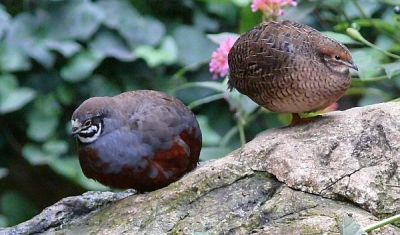
The species of King Quail found naturally occurring in the wild in Victoria Synoicus chinensis victoriae is a subspecies of the more widely distributed King Quail Synoicus chinensis also known as the Chinese Painted Quail or Asian Blue Quail which has widespread distribution from India, through south eastern China, South East Asia and New Guinea to Australia as well as through aviculture.
The King Quail subspecies Synoicus chinensis victoriae (Matthews 1912) is endemic to Australia, it occurs along eastern Australia from Cape York to south eastern South Australia (ALA 2019, Clayton et al. 2006). This subspecies is fully protected and cannot be taken from the wild.
Conservation of the native subspecies is often overlooked due to the prevalence of the more widespread Chinese species in aviculture but as a native species Synoicus chinensis victoriae is in decline in the southern part of its range. It is now considered extinct in South Australia and endangered in Victoria and needs recognition to ensure its long-term survival.
Close relatives of the King Quail are the Stubble Quail Coturnix pectoralis and Brown Quail Coturnix ypsilophora which also occur in Victoria.
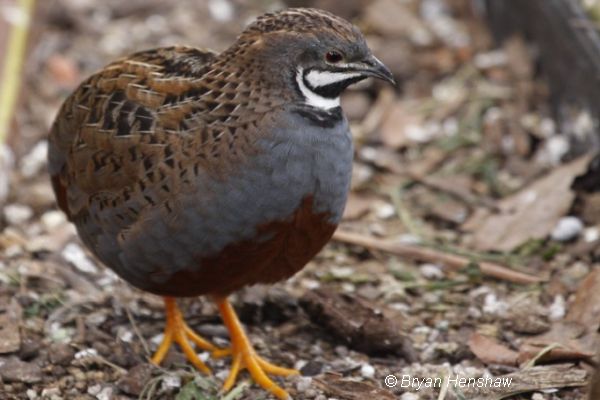
The King Quail is approximately 13-14 cm tall; males have distinctive markings which differentiate them from the Stubble and Brown Quail such as chestnut brown abdomen, slate blue chest, white throat with a black crescent and boarder. Females are generally dark brown above with lighter striations, underside pale with dark barring and white throat.
Taxonomy
It should be noted that a number of variations are applied to the genus of King Quail.
The King Quail was previously referred to as Coturnix, used in many related publications e.g. Victorian Biodiversity Atlas, Victorian Flora and Fauna Guarantee Act 1988 (FFG Act), Advisory List of Threatened Vertebrate Fauna in Victoria (2015) but more recently the geunus Synoicus is used (FFG Threatened List 2023, Australian Faunal Directory 2024).
Excalfactoria, used in older publications, e.g. A Reference -List to the Birds of Australia (1912),
Synoicus, recognised by IUCN Red List 2019, (BirdLife International 2016).
Synoicus, recognised by (Birdlife International datazone 2019).
Distribution
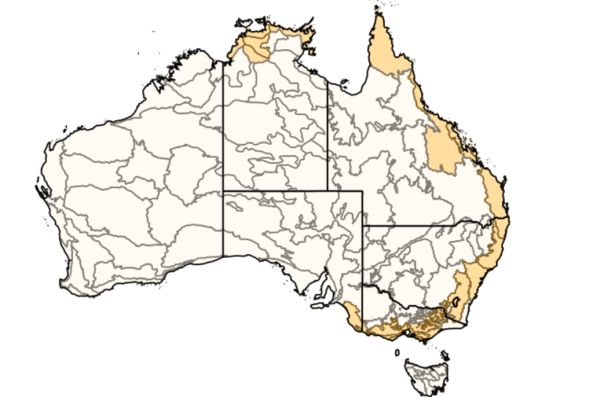
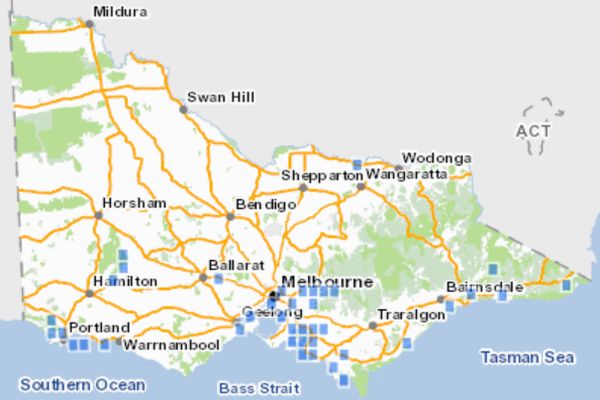
All known (including historic) records of King Quail in Victoria. Data Source: (VBA 2019).
Note: Some historic records could be the introduced Chinese form of King Quail which could provide misleading information regarding the native species range and preferred habitat.
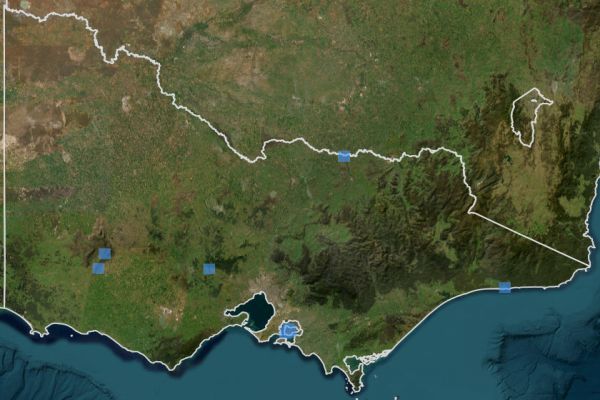
King Quail records between 1990 to 2024 in Victoria. Source VVB 2024 (Source data VBA 2024). French Island is considered the stronghold for this species.. View interactive map (please allow time to load).
French Island is considered the stronghold for this species with most Victorian records and most of the recent records from this area. In Victoria there were only 13 records between 2000 to 2019 with most records on French Island (VBA 2024).
Apart from French Island, records in other parts of Victoria tend to be old e.g. in the Portland area where areas of suitable heathy habitat occur most records date back to the 1950’s and 1990’s with no recent reports. The Grampians has a few records in the Victoria Valley area, most recent 2001. East of Ballarat near Gordon records date back to 1990’s. In Gippsland most records are 1990’s or older, the only exception being near Gippsland Lakes N.P. in 2013 but overall it would appear the species is now mainly confined to French Island.
Reliance on some of the older records and more current records near urban areas could be misleading due to the possibility of these records being the introduced Chinese species or escapes from aviaries. There is documented evidence that the Asian subspecies of King Quail C.c. chinensis was introduced to Victoria on at least three occasions from the early 1860s. This activity would account for some of the early Melbourne sightings of the species near urban areas (O’Brien 2006, O’Brien pers. comm. 2019).
King Quail could still exist in very low numbers at some of its former localities where fire regimes and habitat extent are appropriate and sufficient to support sustainable populations but more intensive surveys are required to reveal the existence of such populations in Victoria.
Ecology & Habitat
King Quail inhabits dense low vegetation, including swamps, wet heathlands, shrubland, swamp scrub, grasslands and crops such as Lucerne (Marchant & Higgins 1993, Trounson & Trounson 1996, O’Brien 2006).
Prime habitat on French Island comprises Wetland Heath EVC, consisting of a low treeless heathland, with small trees Messmate stringybark (Eucalyptus obliqua) and Narrow Leaved Peppermint Gum (Eucalyptus. radiata). Swamp scrub EVC is also an important habitat which occurs along creek lines or where there is poor drainage open understorey consisting of scrub up to 5m in height that is dominated by Melaleuca ericifolia.
It is thought that wet heath vegetation is probably at its best for the King Quail during the first 10 years post burning as the birds like space between plants for movement to avoid predators and to forage. In addition, it is thought that post fire there is a rapid growth and production of seeds which is advantageous to the birds, this is usually sustained for 10 years post burn (Douglas, pers. comm. 2007). For King Quail, the density of vegetation is considered more critical than the height and species present (Marchant & Higgins 1993).
Feeding
King Quail is omnivorous, feeding on a range of food sources including grass seeds, green blades, terrestrial worms, adult larval insects, leaves, grains, fruit and nuts (Marchant & Higgins 1993, Pappas 2001).
Breeding
Breeding in the wild is not well studied but is thought to be almost year-round apart from the winter months. Nests are constructed on the ground and comprise grass tussocks with fine grasses used for the lining, roofed with bent over grasses. The King Quail produces 6-14 eggs at a time which are dark brown with pale brown spots, hatching occurs within 16-19 days (Macdonald 1973, Pappas 2001).
Movement
King Quail tend to be sedentary. They are shy and usually found in pairs or in conveys of 5-6 (sometimes up to 10 individuals) (Morcombe 1986, Marchant & Higgins 1993). King Quail are reluctant to fly and are ‘decidedly tail heavy’, and if are disturbed (or flushed) run or fly as little as 5m high, landing 10-30m away usually into dense vegetative cover (Marchant & Higgins 1993).
Population Status
A species in decline
There has been no species-specific survey or monitoring of King Quail from across its range in Victoria which means it is only possible to speculate on the population size. There are no estimates of the total number or population size of King Quail in Victoria (but it is highly likely to be less than several hundred adult pairs) (O’Brien pers. comm. 2019).
The evidence of (historic) decline is supported by some reports e.g. Dandenong Region CFL (1986) which makes this comment in regards to the King Quail: 'A cause for concern is the decline of this species through loss of habitat. Changes to natural land systems since European settlement have been dramatic. The West Gippsland wetlands have been drained and seventy percent of the land area of the Westernport Catchment has been cleared for agriculture. Urban expansion and recreational demands also threaten the 10% of suitable land which remains in its original state.'
A trend of decline is also evident in the decreasing number and geographic range of sightings.
Populations of King Quail are now most likely confined to National and State Parks and other reserved areas where suitable habitat remains. There has been no Victorian state-wide study of this species but there are indications from local studies that numbers could be very low.
In its final recommendations, the Victorian Flora and Fauna Guarantee (FFG) Scientific Advisory Committee (SAC 1995) determined that the King Quail is:
- in a demonstrable state of decline which is likely to result in extinction
- significantly prone to future threats which are likely to result in extinction
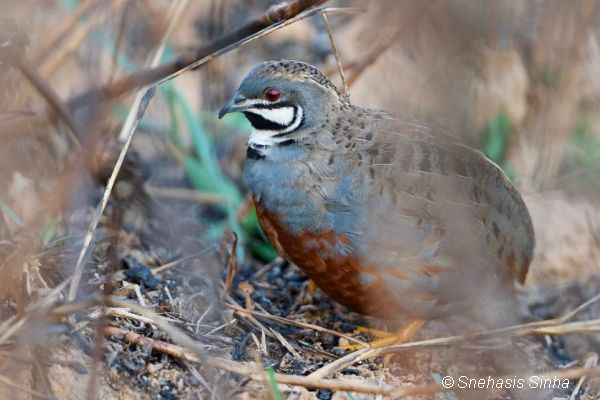
Threats
Loss of habitat
Human activities have had a major impact on this species, particularly in relation to habitat degradation, attributed by the altered drainage of wet health (e.g. in Melbourne), clearing, inappropriate fire regimes (i.e., frequent burning for fire control), extended drought, land development and increased salinity (O’Brien 2006, Marchant & Higgins 1993, SAC 1995, Ingwersen, pers. comm. 2007).
Fire
Inappropriate fire regimes are a major threat to the King Quail’s available habitat, as they usually utilise burnt vegetation 18-24 months post burn (Douglas, pers. comm. 2007). If frequent burning is occurring, for example every year, this makes the habitat inhabitable for the King Quail, as they require dense low vegetation, which is ultimately opened up after a fire and exposes them to predators and reduced food availability.
Predation
Predation from feral cats and foxes is a major issue because being predominately ground dwelling the King Quail has limited capacity to flee from predators, they rely on dense vegetation for cover and may fly for short bursts when disturbed.
Conservation & Management
Suggested conservation measures
- Conduct detailed population surveys and assessment of King Quail populations.
- Carry out more research into the habitat requirements and preferences of the King Quail.
- Determine suitable fire regimes for King Quail habitat.
- Undertake predator control and monitor outcomes on King Quail populations.
- Trial burning regimes to check for habitat preferences for the species
- Encouraging landowners on French Island and in the relevant habitats in the Grampians to report sightings of small dark quail to the Atlas of Victorian Wildlife.
- Flora assessment of known King Quail habitats on French Island and other Victorian sites.
- Reservation and appropriate management of known King Quail habitats in Victoria.
Heathland management
The use of fire to reinvigorate heathlands has been recommended for the Ground Parrot Pezoporus wallicus. As there is limited information available on the management of the King Quail, the management of the rare Ground Parrot (Pezoporus wallicus) in Victoria may serve as an important tool into the management of the King Quail. Both species are ground dwelling persist in heathlands and require an appropriate fire regime for suitable habitat. Studies by Meredith & Jaremovic (1990) could be used as a guide to an adequate fire regime for the King Quail.
On French Island fire management practices have been sympathetic to the maintenance of King Quail habitat.
Research needed
One of the major management issues for this species in particular, is the lack of information available about wild populations of King Quail, specifically in Victoria, i.e. studies, research, monitoring into habitat preference, breeding, species distribution etc. Because the King Quail is a secretive and elusive bird, this species doesn’t attract much attention from the general public hence a reason why little is known about the wild populations.
Surveys
There has been no dedicated survey or monitoring effort for King Quail in Victoria for at least the past 10 years. Previous survey work was largely undertaken by Friends of French Island National Park volunteers with the support of Parks Victoria.
The majority of Victorian King Quail sightings are brief glimpses of birds on French Island. The species is very hard to detect in its preferred habitat (most reliably by males calling during the breeding season). ‘The bird is very difficult to observe and hence survey, due to its preference for dense and swampy heathland habitat, and because it seldom flies and is very difficult to flush’ (Frith 1969).
Projects & Partnerships
Friends of French Island have played a major role in advancing knowledge relating to the distribution of King Quail on French Island through regular surveys.
Parks Victoria has been involved with a long-term Feral Cat Eradication program implemented in the French Island National Park.
Parks Victoria undertakes weed control of the invasive weed, Bridal creeper (Asparagus asparagoides). This has been an on-going program at French Island National Park. Weed control assists King Quail habitat by preventing this weed from taking over the understorey of swamp scrub vegetation.
The French Island Landcare Group have been undertaking on-going feral cat control on French Island since 2012 with the removal of >1000 cats (Johnston & Znidersic 2018).
Report King Quail sightings in the wild in Victoria to the Victorian Biodiversity Atlas
References & Links
Australian Faunal Directory (2024) Subspecies Synoicus chinensis victoriae (Mathews, 1912) Australian Faunal Directory Accessed 19 February 2024.
Clayton, M., Wombey, J.C., Mason, I.J., Chesser, R.T. & Wells, A. (2006), CSIRO List of Australian Vertebrates: A Reference with Conservation Status, 2nd edn, CSIRO Publishing, Melbourne.
Douglas, M. (2007) Ranger, French Island, Parks Victoria.
DSE (2013) Advisory List of Threatened Vertebrate Fauna-2013, Department of Sustainability & Environment, Victoria. (now Department of Environment, Land, Water and Planning (DELWP), Victoria.
FFG Threatened List (2023) Flora and Fauna Guarantee Act 1988 - Threatened List - June 2023
Ingwersen, D. (2007) Threatened Bird Network Coordinator - Threatened Bird Network, Birds Australia. 2 October,2007
IUCN (2019) The IUCN Red List of Threatened species. Birdlife International 2016 Synoicus chinensis (Downloaded 02 May 2019).
BirdLife International (2019) BirdLife International data zone fact sheet Asian Blue Quail Synoicus chinensis (Accessed 08/04/2019)
Macdonald, J.D. (1973) Birds of Australia, A summary of Information, A.H & A. W Reed Pty Ltd, Sydney, Australia.
Johnston, M., Znidersic, E. (2018) Technical Report, Recommendations for the effective monitoring of cats and wildlife as part of an enhanced cat management program on French Island. ResearchGate.
Marchant, S. & Higgins, P.J. eds. (1993) Handbook of Australian, New Zealand & Antarctic Birds, Vol 2, Raptors to Lapwings, Oxford University Press, Melbourne, Australia.
Meredith, C., & Jaremovic, R. (1990) Current status and management of the Ground Parrot in Victoria, Arthur Rylah Institute for Environmental Research, Technical Report Series No. 58, Department of Conservation, Forests & Lands, East Melbourne.
NPWA (2018), National Parks and Wildlife Act 1972—Version: 4.10.2018 South Australia.
O’Brien, M. (2006) ‘Distribution, Habitat and Status of the King Quail Coturnix chinensis victoriae in Victoria: The Importance of French Island, Western Port Bay’, Australian Field Ornithology, vol. 23, pp. 62-76. ResearchGate.
O’Brien, M. (2007) Wildlife Biologist - Threatened Species & Communities Section, Department of Sustainability and Environment. 17 September & 3, 9 October 2007
O'Brien (2019) Martin O’Brien pers. comm. 2019, MOB Ecological Consulting.
Pappas, J. (2001) Coturnix chinensis (On-line), Animal Diversity Web. Accessed 09 May 2019.
SAC (1995) Final Recommendation on a nomination for listing: King Quail Coturnix chinensis (Nomination No. 349). Scientific Advisory Committee, Flora and Fauna Guarantee. Department of Sustainability and Environment: Melbourne.
Trounson, D. & Trounson, M. (1996) Australian Birds Simply Classified, National Book Distributors and Publishers, French Forests, New South Wales, Australia.
VBA (2019) Victorian Biodiversity Atlas, Department of Environment, Land, Water and Planning, Victoria.
VVB (2019) Visualising Victoria's Biodiversity
Please contribute information regarding King Quail in Victoria - observations, images or projects. Contact SWIFFT

